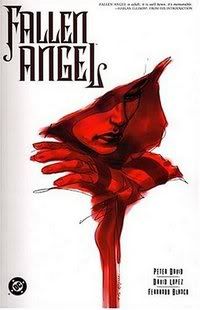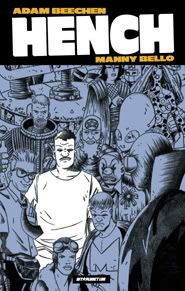ULTIMAN GIANT-SIZED ANNUAL #1
By various writers and artists
Publish by Image/Big Bang
The creators from Big Bang Comics bring us six stories (as well as some Hightest Honey Pies), that aren't really from 1964 but don't really belong in 2001 either in this month's one-shot; Ultiman Giant-Sized Annual #1.
Once again, the retro-bug has chomped me in the behind this month. I expected good things from AC Comics's Fighting Yank, and in fact I was disappointed when I was only able to snag a copy of it a week after its release. I didn't expect much from Ultiman, though. Maybe I'm just more a creature of the Golden Age than the Silver, or maybe I just haven't been happy with most of Image's material, but for whatever reason while I hoped Fighting Yank would stand apart from the crowd, I harbored more than one or two preconceived notions that convinced me Ultiman would be just another dehydrated cough from a well that is dangerously close to running dry, if it hasn't already.
Nothing could be further from the truth. In fact, I suspect in the weeks and months to come, I'll find myself scanning the racks for more comics with the Big Bang label on the cover. For those who might not believe the writers of yesteryear compare the scribes of today, Ultiman is the burning bush that will convert your fanboy butt for good. What will probably come to your mind almost immediately after closing the pages of this one-shot is how much more skilled the writers of the past were at giving us stories that were only a few pages long while still giving us a feeling of completion.
Remember the horrible Marvel crossover annuals of the nineties? When it came to short-short comic stories, the writers of the nineties weren't able to give us anything more than brief morality plays with second-rate art and third-tier characters, all in the form of one big oversized, over-priced piece of crap that wouldn't make much sense anyway unless we went out and bought all the other "Atlantis Attacks!" or "Evolutionary War" issues. Like the writers of the sixties, the authors of these six stories are able to give us tales that don't take up much room, but don't make you feel like you've just ingested the comicdom version of fast food, either.
The first story is "The Human Lightning Rod," in which Ultiman does battle with a lightning storm which seems to have targetted a pretty young girl. What struck me about this first story is the relationship between Ultiman and his alter-ego. While the world seems to know that Chris Kelly is Ultiman, what they don't know is that when he's not leaping tall buildings, he poses as Carl Kelly, Chris Kelly's brother who has nothing nice to say about the blue-clad champion of justice. I thought this was quite an original idea, especially from a comic which mirrors stories of the past. By the way, though Ultiman is an obvious Superman-clone, he is also a bonafide hero of Big Bang Comics who appears outside of this one-shot.
In the second story, "The Day Ultiman's Powers Went Wild," Ultiman's super-hearing is pushed beyond its boundaries after Ultiman handles a deadly piece of Ultranium (the same substance which gave Ultiman his Ultra-powers so he could protect people just like Ultimate Spider-Man and then go home and play Ultima). At first, the power boost helps Ultiman deal with the many dangers the inhabitants of Empire City face, but eventually the sounds of the city are too much for his senses. Ultiman's solution at the end of the story is cute, but does leave you feeling a little incomplete.
The third story is probably my favorite; "The Beatnik From Outer Space." The hero of this story is the super-strong fireplug ThunderGirl. When ThunderGirl spots a drill-shaped spaceship plummeting towards Earth, she hurries to the scene of the crash where, instead of the little green aliens she was expecting, she finds Bongo Bill: the Beatnik From Outer Space. Well, not really from outer space. It turns out that Bill was abducted by aliens in 1961 while he was playing his bongos in the park (dig?). After three years of endless and fruitless interrogation of the beatnik, the aliens have returned to destroy the Earth.
Bongo Bill's dialogue pretty much makes this story. It's almost worth the price of the comic just to read groovy lines like, "It didn't crash, blondie! The nosecone is a giant drill, Jill!" and "Like, we're all doomed!"
The hero whose name graces the cover of this comic is once again absent in, "The Thing From Zugan." Instead of Ultiman, the giant alien who lands in the South Pacific and starts tearing up everything he sees has to face the fury of Blackjack and his Flying Aces. This is another of the more enjoyable stories in the comic. Mike Robert's penciling style is wonderfully and weirdly unique, and while only 11 pages long, this is probably the most complete story in the issue.
Ultiman returns, along with Gary Carlson's scripting in "The Curse of King Tut's Tomb." The villain Purpleface and his pack of goons break into a museum exhibit, only to awaken the ancient and powerful evil of King Tut. When Ultiman intervenes, King Tut's curse latches onto him with hilarious effect. We get to see Ultiman turn into old Ultiman, Woman Ultiman, Child Ultiman, Big Fat Ultiman, among others. Ultiman eventually finds a way to defeat King Tut, aided by the powerful hero known as the Great Pyramid (big guy + a pyramid for a head).
Daniel Reed brings us the story and art for the final chapter of the Ultiman Giant-Sized Annual; "The Secret Origin of The Great Pyramid." Archaeologist Adam Rush and his greedy partner Nathan Nether find their way into an ancient pyramid, only to be caught between the fury of two rival gods and granted powers to fight in the respecitve gods's names; one for evil, one for good. A fitting end to a great issue.
But the issue isn't quite over just yet. The funniest part of the issue isn't inside the comic but on the back cover. Nat Gertler and Mark Lewis will have you laughing your butt off with "The Cavity Crusade," a darkly humorous homage to the Hostess Twinkie ads of the seventies. Savage Dragon fans might be shaking their heads and moaning, "been there, done that," but Gerler's and Lewis's rendition is a bit different from the parody ads you'll find in the pages of the mighty finhead.
So do your funny bone and your inner child a favor and pick up a copy of Ultiman Giant-Sized Annual #1.
Daddy-O.

 Fallen Angel
Fallen Angel Hench
Hench